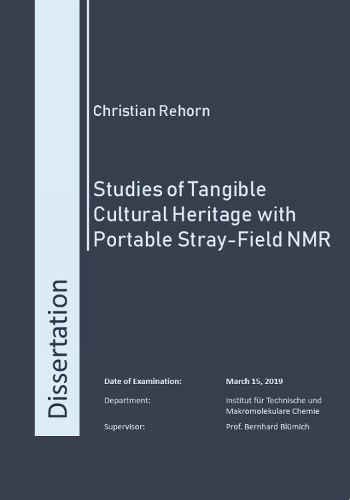Studies of Tangible Cultural Heritage with Portable Stray-Field NMR
Dr Christian Rehorn

Studies of Tangible Cultural Heritage with Portable Stray-Field NMR
Dr Christian Rehorn
Sensors for stray-field nuclear magnetic resonance (NMR) have been employed to measure tangible cultural heritage since they were first conceived. Although NMR is a method with inherently low sensitivity and requires larger amounts of time than many other techniques, it is non-destructive and grants access to spin densities and relaxation times, physical quantities which are exclusive to the method. This thesis describes theory, instrumentation, and applications of unilateral NMR in the field of cultural heritage.
The detection zone of an NMR-MOUSE, a sensor developed and maintained by past and present members of the group of Professor Bluemich, is mapped through back-projection for the first time. Traditionally, the signal arising from the detection volume was averaged over multiple scans until the signal response was satisfactory. In this work, an algorithm is proposed to improve the signal-to-noise ratio in magnetization decays as a method of post processing an output, which contains the individual data from smaller sub-experiments.
One of the most prominent fields of application for unilateral NMR is the investigation of porosity in stone and soil. In a study of ancient mortars in Herculaneum, a city buried by the ashes of Mount Vesuvius during the famous eruption of 79 AD, the profiles of over 60 sites, fragments and mock-ups were compared for the first time with methods known from statistics and pattern recognition. The effects of high temperatures up to 900 degreesC on low and high-density sandstone were determined in terms of their transverse relaxation times. Mock-ups were cross referenced with actual walls and fragments to assess the damage of the western wall of the burnt down Mackintosh Library in Glasgow.
Studies of paint show how stray-field sensors can help evaluating solvent activity and their potential as cleaning agents. Relaxation times assess embrittlement and transient softening caused by such treatments. Furthermore, the potential to detect or even discriminate natural and artificial aging of binder polymers is explored.
The impressive sound and quality of historic instruments by Stradivari and his contemporaries is still unsurpassed in the opinion of many musicians, but the reason for this remains controversial. When tested with unilateral NMR, violins and violas from the golden age of luthiers revealed a homogeneous wood density throughout their maple back plate. Shorter relaxation times at the wood surfaces may be traces of previous treatments.
Even though unilateral NMR equipment was claimed to be portable for many years, it had relied on grid power and shielding from weather. This work presents the efforts of measuring biofilms in Yellowstone National Park, relying on battery power to perform the non-destructive tests. An NMR-MOUSE was constructed and waterproofed to detect biofilms under water and in-situ.
This item is not currently in-stock. It can be ordered online and is expected to ship in approx 2 weeks
Our stock data is updated periodically, and availability may change throughout the day for in-demand items. Please call the relevant shop for the most current stock information. Prices are subject to change without notice.
Sign in or become a Readings Member to add this title to a wishlist.


